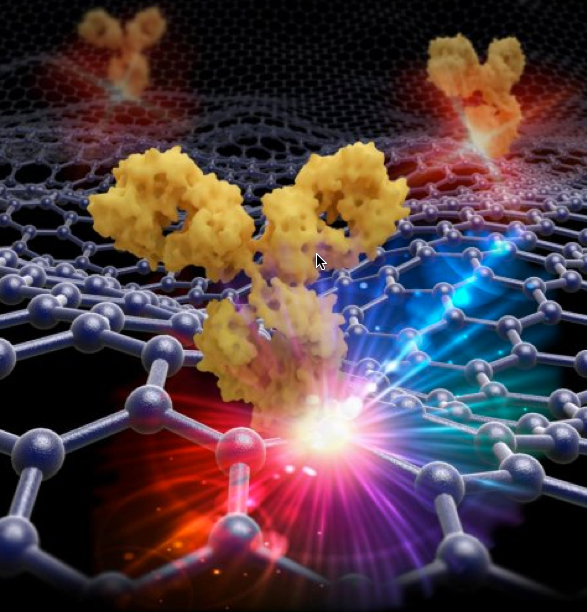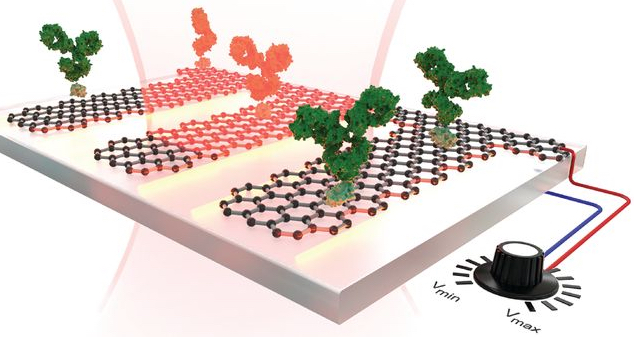A graphene-based molecule sensor
July 9, 2015

Shining infrared light on a graphene surface makes surface electrons oscillate in different ways that identify the specific molecule attached to the surface (EPFL/Miguel Spuch /Daniel Rodrigo )
European scientists have harnessed graphene’s unique optical and electronic properties to develop a highly sensitive sensor to detect molecules such as proteins and drugs — one of the first such applications of graphene.
The results are described in an article appearing in the latest edition of the journal Science.
The researchers at EPFL’s Bionanophotonic Systems Laboratory (BIOS) and the Institute of Photonic Sciences (ICFO, Spain) used graphene to improve on a molecule-detection method called infrared absorption spectroscopy, which uses infrared light is used to excite the molecules. Each type of molecule absorbs differently across the spectrum, creating a signature that can be recognized.
This method is not effective, however, in detecting molecules that are under 10 nanometers in size (such as proteins), because the size of the mid-infrared wavelengths used are huge in comparison — 2 to 6 micrometers (2,000 to 6,000 nanometers).

Conceptual view of the graphene biosensor. An infrared beam excites a plasmon resonance across the graphene nanoribbons. Protein sensing is achieved by changing the voltage applied to the graphene and detecting a plasmon resonance spectral shift accompanied by narrow dips corresponding to the molecular vibration bands of the protein. (credit: Daniel Rodrigo et al./Science)
Resonant vibrations
With the new graphene method, the target proteins to be analyzed are attached to the graphene surface. “We pattern nanostructures on the graphene surface by bombarding it with electron beams and etching it with oxygen ions,” said Daniel Rodrigo, co-author of the publication. “When the light arrives, the electrons in graphene nanostructures begin to oscillate. This phenomenon, known as ‘localized surface plasmon resonance,’ serves to concentrate light into tiny spots, which are comparable with the [tiny] dimensions of the target molecules. It is then possible to detect nanometric structures.”
This process can also reveal the nature of the bonds connecting the atoms that the molecule is composed of. When a molecule vibrates, it does so in a range of frequencies, which are generated by the bonds connecting the different atoms. To detect these frequencies, the researchers “tuned” the graphene to different frequencies by applying voltage, which is not possible with current sensors. Making graphene’s electrons oscillate in different ways makes it possible to “read” all the vibrations of the molecule on its surface. “It gave us a full picture of the molecule,” said co-author Hatice Altug.
According to the researchers, this simple method shows that it is possible to conduct a complex analysis using only one device, while it normally requires many different ones, and without stressing or modifying the biological sample. “The method should also work for polymers, and many other substances,” she added.
Abstract of Mid-infrared plasmonic biosensing with graphene
Infrared spectroscopy is the technique of choice for chemical identification of biomolecules through their vibrational fingerprints. However, infrared light interacts poorly with nanometric-size molecules. We exploit the unique electro-optical properties of graphene to demonstrate a high-sensitivity tunable plasmonic biosensor for chemically specific label-free detection of protein monolayers. The plasmon resonance of nanostructured graphene is dynamically tuned to selectively probe the protein at different frequencies and extract its complex refractive index. Additionally, the extreme spatial light confinement in graphene—up to two orders of magnitude higher than in metals—produces an unprecedentedly high overlap with nanometric biomolecules, enabling superior sensitivity in the detection of their refractive index and vibrational fingerprints. The combination of tunable spectral selectivity and enhanced sensitivity of graphene opens exciting prospects for biosensing.